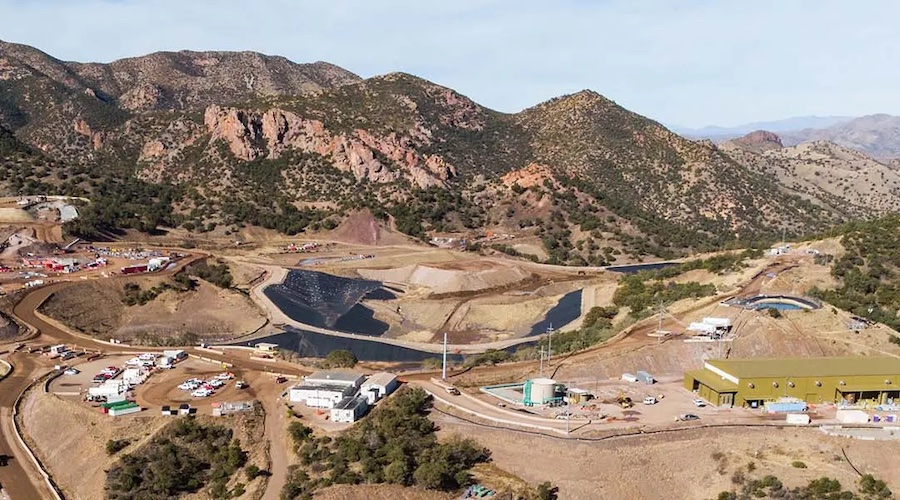Nexen wins regulatory approval for major expansion

Oil sands producer, Nexen Inc. (TSX, NYSE: NXY), said it received regulatory approval to proceed with development of pads 14 and 15 at Long Lake and the Kinosis 1A area.
The company says the pads, which will reach staged completion dates between 2013 and 2014, will increase bitumen production.
Pads are used to inject steam underground and push the oil to the surface.
Full news release is here:
Nexen Announces Continued Progress on Long Lake Action Plan
Long Lake Pad 12 Steaming, Regulatory Approvals Received for Future Pads
CALGARY, April 16, 2012 /CNW/ – Nexen Inc. (TSX, NYSE: NXY) today announced that we have reached two significant milestones in our plan to fill the Long Lake upgrader to capacity. We recently began steaming pad 12 on the Long Lake lease. Additionally, we have received the necessary regulatory approvals to proceed with the development of pads 14 and 15 at Long Lake and the Kinosis 1A area. The wells on these pads are located in high-quality resource areas.
“Achieving first steam at pad 12 and securing approvals for the remainder of our wells are key steps in our strategy to increase bitumen production and fill the upgrader,” said Kevin Reinhart, Nexen’s interim President & CEO. “Obtaining regulatory approval allows us to commence drilling the wells this summer.”
Over the next few years, we expect to fill the upgrader with bitumen from the following sources:
Number of Wells Expected Peak Rates Current Rates Status
Pads 1-11 90 30,000 – 44,000 34,500 Producing
Pads 12 & 13 18 11,000 – 17,000 0 Steaming Pad 12
Pads 14 & 15 11 4,000 – 7,000 0 Approvals Secured
Kinosis 1A 29 15,000 – 25,000 0 Approvals SecuredOur plan to fill the upgrader starts with increasing production from the existing 11 pads. The average bitumen production rate for the first quarter of 2012 was approximately 34,500 bbls/d, a 10% increase from the prior quarter. Pad 11, our newest producing pad, continues to ramp-up; recent rates of 5,700 bbls/d are trending toward the upper end of our expected range of 4,000 to 8,000 bbls/d.
Steaming on pad 12 started in March as planned and production is expected to begin there this summer. Completion work is underway on pad 13 and steam injection is expected to commence mid-year; bitumen production is expected to begin before the end of the year. Production from these pads is expected to ramp-up to full rates over an 18-24 month period.
With regulatory approvals now received, drilling is expected to commence on pads 14, 15 and Kinosis 1A later this year. Steam injection is expected on pads 14 and 15 in the second half of 2013, with Kinosis 1A following by mid-year 2014. Our winter 2011 core hole program has confirmed the high quality of resource in each of these areas. It has also allowed us to finalize the initial number of wells to be drilled in each area and to optimize the well layouts. For pads 14 and 15, the optimum well configuration calls for shorter well lengths, resulting in a lower production range on these pads.
Nexen has a 65% working interest in both Long Lake and Kinosis and is the operator. The remaining 35% interest is held by CNOOC Limited.
About Nexen
Nexen Inc. is an independent, Canadian-based global energy company, listed on the Toronto and New York stock exchanges under the symbol NXY. Nexen is focused on three growth strategies: oil sands and shale gas in Western Canada and conventional exploration and development primarily in the North Sea, offshore West Africa and deepwater Gulf of Mexico. Nexen adds value for shareholders through successful full-cycle oil and gas exploration and development, and leadership in ethics, integrity, governance and environmental stewardship.
Forward-Looking Statements
Certain statements in this Release constitute “forward-looking statements” (within the meaning of the United States Private Securities Litigation Reform Act of 1995, as amended) or “forward-looking information” (within the meaning of applicable Canadian securities legislation). Such statements or information (together “forward-looking statements”) are generally identifiable by the forward-looking terminology used such as “anticipate”, “believe”, “intend”, “plan”, “expect”, “estimate”, “budget”, “outlook”, “forecast” or other similar words and include statements relating to or associated with individual wells, regions or projects. Any statements as to possible future crude oil or natural gas prices; future production levels; future royalties and tax levels; future capital expenditures, their timing and their allocation to exploration and development activities; future earnings; future asset acquisitions or dispositions; future sources of funding for our capital program; future debt levels; availability of committed credit facilities; possible commerciality of our projects; development plans or capacity expansions; the expectation that we have the ability to substantially grow production at our oil sands facilities through controlled expansions; the expectation of achieving the production design rates from our oil sands facilities; the expectation that our oil sands production facilities continue to develop better and more sustainable practices; the expectation of cheaper and more technologically advanced operations; the expected design size of our facilities; the expected timing and associated production impact of facility turnarounds and maintenance; the expectation that we can continue to operate our offshore exploration, development and production facilities safely and profitably; future ability to execute dispositions of assets or businesses; future sources of liquidity, cash flows and their uses; future drilling of new wells; ultimate recoverability of current and long-term assets; ultimate recoverability of reserves or resources; expected finding and development costs; expected operating costs; future cost recovery oil revenues from our Yemen operations; the expectation of our ability to comply with the new safety and environmental rules enacted in the US at a minimal incremental cost, and of receiving necessary drilling permits for our US offshore operations; estimates on a per share basis; future foreign currency exchange rates; future expenditures and future allowances relating to environmental matters and our ability to comply with them; dates by which certain areas will be developed, come on stream or reach expected operating capacity; and changes in any of the foregoing are forward-looking statements.
Statements relating to “reserves” or “resources” are forward-looking statements, as they involve the implied assessment, based on estimates and assumptions that the reserves and resources described exist in the quantities predicted or estimated and can be profitably produced in the future.
All of the forward-looking statements in this Release are qualified by the assumptions that are stated or inherent in such forward-looking statements. Although we believe that these assumptions are reasonable based on the information available to us on the date such assumptions were made, this list is not exhaustive of the factors that may affect any of the forward-looking statements and the reader should not place an undue reliance on these assumptions and such forward-looking statements. The key assumptions that have been made in connection with the forward-looking statements include the following: that we will conduct our operations and achieve results of operations as anticipated; that our development plans will achieve the expected results; the general continuance of current or, where applicable, assumed industry conditions; the continuation of assumed tax, royalty and regulatory regimes; the accuracy of the estimates of our reserve volumes; commodity price and cost assumptions; the continued availability of adequate cash flow and debt and/or equity financing to fund our capital and operating requirements as needed; and the extent of our liabilities. We believe the material factors, expectations and assumptions reflected in the forward-looking statements are reasonable, but no assurance can be given that these factors, expectations and assumptions will prove to be correct.
Forward-looking statements are subject to known and unknown risks and uncertainties and other factors, many of which are beyond our control and each of which contributes to the possibility that our forward-looking statements will not occur or that actual results, levels of activity and achievements may differ materially from those expressed or implied by such statements. Such factors include, among others: market prices for oil and gas; our ability to explore, develop, produce, upgrade and transport crude oil and natural gas to markets; ultimate effectiveness of design or design modifications to facilities; the results of exploration and development drilling and related activities; the cumulative impact of oil sands development on the environment; the impact of technology on operations and processes and how new complex technology may not perform as expected; the availability of pipeline and global refining capacity; risks inherent to the operations of any large, complex refinery units, especially the integration between production operations and an upgrader facility; availability of third-party bitumen for use in our oil sands production facilities; labour and material shortages; risks related to accidents, blowouts and spills in connection with our offshore exploration, development and production activities, particularly our deep-water activities; direct and indirect risks related to the imposition of moratoriums, suspensions or cancellations of our offshore exploration, development and production operations, particularly our deep-water activities; the impact of severe weather on our offshore exploration, development and production activities, particularly our deep-water activities; the effectiveness and reliability of our technology in harsh and unpredictable environments; risks related to the actions and financial circumstances of our agents and contractors, counterparties and joint venture partners; volatility in energy trading markets; foreign currency exchange rates; economic conditions in the countries and regions in which we carry on business; governmental actions including changes to taxes or royalties, changes in environmental and other laws and regulations including without limitation, those related to our offshore exploration, development and production activities; renegotiations of contracts; results of litigation, arbitration or regulatory proceedings; political uncertainty, including actions by terrorists, insurgent or other groups, or other armed conflict, including conflict between states; and other factors, many of which are beyond our control.
These risks, uncertainties and other factors and their possible impact are discussed more fully in the sections titled “Risk Factors” in our 2011 Annual Information Form and “Quantitative and Qualitative Disclosures About Market Risk” in our 2011 annual MD&A. The impact of any one risk, uncertainty or factor on a particular forward-looking statement is not determinable with certainty as these factors are interdependent, and management’s future course of action would depend on our assessment of all information at that time. Although we believe that the expectations conveyed by the forward-looking statements are reasonable based on information available to us on the date such forward-looking statements were made, no assurances can be given as to future results, levels of activity and achievements. Undue reliance should not be placed on the forward-looking statements contained herein, which are made as of the date hereof as the plans, intentions, assumptions or expectations upon which they are based might not occur or come to fruition. Except as required by applicable securities laws, Nexen undertakes no obligation to update publicly or revise any forward-looking statements, whether as a result of new information, future events or otherwise. Included herein is information that may be considered financial outlook and/or future-oriented financial information (FOFI). Its purpose is to indicate the potential results of our intentions and may not be appropriate for other purposes. The forward-looking statements contained herein are expressly qualified by this cautionary statement.
Note to Investors on Reserves and Resources
The reserves estimates in this disclosure were prepared with an effective date of December 31, 2011. The resource estimates were prepared on March 31, 2012. These estimates have been internally prepared by an internal qualified reserves evaluator in accordance with National Instrument 51-101 Standards of Disclosure for Oil and Gas Activities (“NI 51-101”) and the Canadian Oil and Gas Evaluation Handbook (“COGE Handbook”). For more information on this reserves estimate and Nexen’s reserves estimation process please refer to our 2011 Annual Information Form.
The estimates of contingent recoverable resource in this press release reflect our low, best, and high estimates. A “best estimate” is the estimate of the quantity of resources that will actually be recovered. It is equally likely that the actual quantities recovered will be greater or less than the best estimate. Those resources that fall within the best estimate have a 50% confidence level that the actual quantities recovered will equal or exceed the estimate. The ‘low estimate’ and ‘high estimate’ are considered to be conservative and optimistic estimates of resources with 90% and 10% confidence, respectively. Contingent resources are quantities of petroleum estimated, as of a given date, to be potentially recoverable from known accumulations using established technology or technology under development, but which are not currently considered to be commercially recoverable due to one or more contingencies. Contingencies on resources may include, but are not limited to, factors such as economic, legal, environmental, political and regulatory matters or a lack of markets. Specific contingencies precluding these contingent resources being classified as reserves include but are not limited to: future drilling program results, drilling and completions optimization, stakeholder and regulatory approval of future drilling and infrastructure plans, access to required infrastructure, economic fiscal terms, a lower level of delineation, the absence of regulatory approvals, detailed design estimates and near-term development plans, and general uncertainties associated with this early stage of evaluation. There is no certainty that it will be commercially viable to produce any portion of the resources.
Conversions of gas volumes to boe in these estimates were made on the basis of 1 boe to 6 mcf of natural gas. A boe conversion ratio of 6 mcf:1 bbl is based on an energy equivalency conversion method primarily applicable at the burner tip and does not represent a value equivalency at the wellhead. Using the forecast prices applied to our reserves estimates, the boe conversion ratio based on wellhead value is approximately 30 mcf:1 bbl. Disclosure provided herein in respect of boes may be misleading, particularly if used in isolation.
For investor relations inquiries, please contact:Janet Craig
Vice President, Investor Relations
(403) 699-4230
For media and general inquiries, please contact:Pierre Alvarez
Vice President, Corporate Relations
(403) 699-5202801 – 7th Ave SW
Calgary, Alberta, Canada T2P 3P7
More News
South32 breaks ground on remote operating center at Hermosa project in Arizona
April 24, 2025 | 04:20 pm
{{ commodity.name }}
{{ post.title }}
{{ post.date }}



Comments